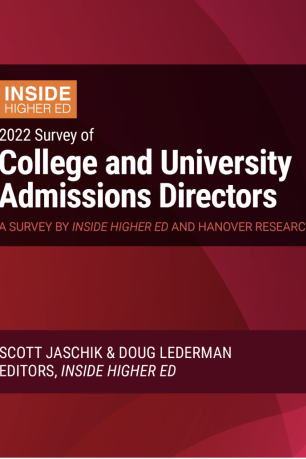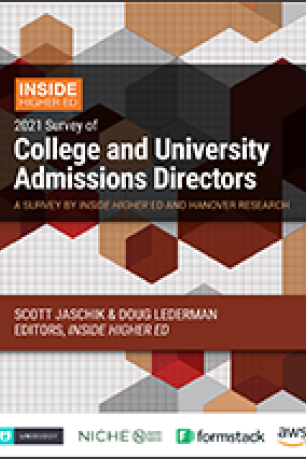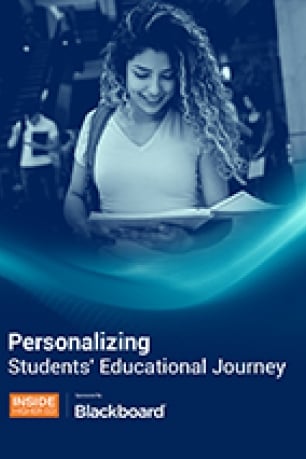Free Download
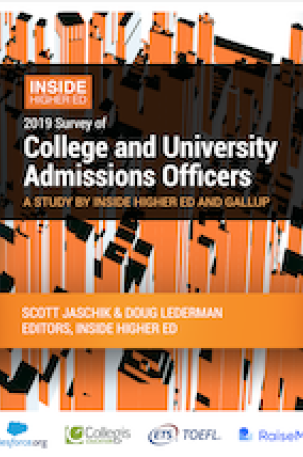
Last year, in response to suggestions of admissions counselors, Inside Higher Ed changed the question it asked of admissions directors about when they filled their class. In addition to asking if they had filled their class by May 1 (the traditional date), we asked if they had filled the class by June 1. Only the public doctoral universities category showed a majority filling their classes by May 1, and asking about June 1 resulted in majorities for private institutions.
This year we asked if admissions leaders filled their classes by July 1 (in addition to the earlier deadlines). Administrators at a majority of institutions answered no.
That's one of the findings of the 2019 Inside Higher Ed Survey of College and University Admissions Officials, conducted by Gallup.
Other findings, from the 336 admissions leaders who answered:
- A majority of those who answered were very concerned about filling their classes.
- Sixty-five percent of admissions directors said they were seeking more out-of-state students -- although notably this does not appear to be motivated by out-of-state tuition rates (as was the case in prior years).
- A majority (58 percent) are concerned about maintaining current levels of international students. The number that says they believe they will have to offer aid is going up.
About the Survey
Inside Higher Ed's 2019 Survey of College and University Admissions Officers was conducted in conjunction with researchers from Gallup. Inside Higher Ed regularly surveys key higher ed professionals on a range of topics.
You may download a full survey report here.
On Tuesday, Oct. 22, at 2 p.m. Eastern, Inside Higher Ed will present a free webcast to discuss the results of the surveys. Sign up here.
The Inside Higher Ed survey of admissions directors was made possible in part by support from Salesforce, Collegis Education, ETS TOEFL and RaiseMe.
- A large majority believe they are losing potential applicants because of concerns about debt. The figure is over 90 percent for private institutions.
- A majority (60 percent) believe that the Varsity Blues scandal has hurt the image of colleges generally, but relatively few believe it has hurt their institutions.
- A majority (60 percent) of admissions leaders believe that colleges should be able to consider race and ethnicity in admissions decisions, with support strong at private institutions.
- More than half of colleges in the survey require the SAT or ACT for admissions, and 63 percent said they expect no change 10 years from now. That's a drop from 76 percent last year.
- Most college admissions directors (81 percent) said that students admitted from the waiting list make up less than 5 percent of the class.
Deadlines
The deadline for filling a class keep getting pushed back. Fifty-two percent of colleges did not meet their goals by July 1. And only 37 percent achieved their goals by May 1.
There were significant gaps by sector:
| Public Doctoral | Public Master's/Bachelor's | Public Community College | Private Doctoral/Master's | Private Bachelor's | |
| Met goal by May 1 | 45% | 36% | 33% | 44% | 29% |
| Met goal by June 1 | 9% | 3% | 3% | 5% | 18% |
| Met goal by July 1 | 5% | 9% | 3% | 5% | 2% |
| Didn't meet goal by July 1 | 40% | 52% | 61% | 46% | 52% |
To be sure, community colleges and other open-access institutions have long ignored the May 1 deadline for filling a class. But this year, the proportion saying they had completed a class by May 1 was lower at private bachelor's institutions than at community colleges.
The low numbers filling their classes by May 1 could also influence how the National Association for College Admission Counseling votes this week on proposals to lift limits on colleges recruiting students who have committed to a college by May 1. (The Justice Department believes that such limits constitute violations of antitrust laws.)
The numbers also are reflected in the answers to another question in the survey: "Thinking back, please indicate how concerned you were about meeting your institution's new student enrollment goals this year."
| Public Doctoral | Public Master's/Bachelors | Public Community College | Private Doctoral/Master's | Private Bachelor's | |
| Very concerned | 41% | 54% | 66% | 54% | 47% |
| Moderately concerned | 31% | 41% | 29% | 25% | 36% |
| Not too concerned | 20% | 5% | 5% | 11% | 14% |
| Not concerned at all | 8% | 0% | <1% | 10% | 3% |
The percentages reflect extreme levels of concern throughout higher education.
Varsity Blues
This year brought the Varsity Blues scandal -- in which parents were arrested and pleaded guilty to effectively bribing their children into competitive colleges.
The admissions directors believe that the scandal has hurt higher education generally and the colleges that were involved in the scandal, but they don't believe that it damaged their own colleges.
 Seventeen percent said that the scandal had hurt the image of the colleges involved "a great deal" and 43 percent said it had hurt them a "fair amount." (The institution with the most students admitted through unethical means was the University of Southern California, but the scandal also touches Stanford and Yale Universities.)
Seventeen percent said that the scandal had hurt the image of the colleges involved "a great deal" and 43 percent said it had hurt them a "fair amount." (The institution with the most students admitted through unethical means was the University of Southern California, but the scandal also touches Stanford and Yale Universities.)
Thirteen percent said higher education has been hurt a great deal, and 45 percent a fair amount.
But when it came to their own institutions, less than 1 percent said it had affected them a great deal and only 2 percent said it had affected them a fair amount.
Many of the Varsity Blues cases involved parents bribing coaches to put the students on their admit lists as if they were talented varsity athletes. Fourteen percent of admissions leaders said that the image of coaches and athletes has suffered a great deal, and 47 percent said a fair amount.
The admissions leaders also indicated that athletes have too many advantages in the admissions system.
Sixty-five percent of them agreed or strongly agreed that "the indictments revealed that applicants admitted as athletes have too many advantages over other applicants."
And 51 percent agreed or strongly agreed that "I am concerned that people have lost faith in the fairness of the admissions process."
Forty-two percent said their colleges had taken steps to assure applicants about the fairness of the system.
Varsity Blues is not the only admissions scandal out there. ProPublica reported on wealthy parents in the Chicago area giving up guardianship of their children so they could apply for more aid. The practice is apparently legal (in some circumstances), but many of the parents have reversed course since it became public.
While the incident shocked admissions leaders when it was reported, and the stories were only about the Chicago suburbs, 11 percent of admissions leaders surveyed said they had heard of parents in their communities giving away guardianship of their children for the same reason.
The practice is not popular with admissions leaders. Seventy-nine percent of survey respondents said that the requirements should be made tougher for parents to do this.
Affirmative Action
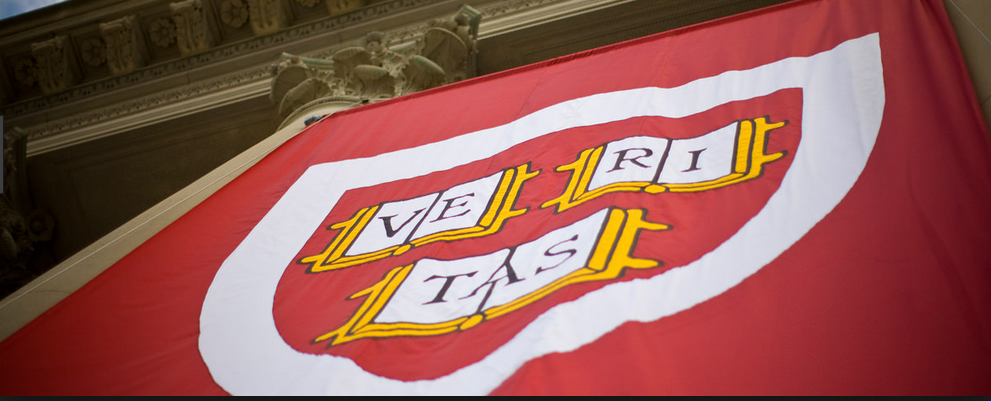 Colleges are waiting for a decision -- it could be out any day now -- on a lawsuit against Harvard University's use of affirmative action in admissions.
Colleges are waiting for a decision -- it could be out any day now -- on a lawsuit against Harvard University's use of affirmative action in admissions.
The survey results illustrate that most colleges do not consider race or gender in admissions decisions -- they aren't competitive enough for it to make a difference. There is also more opposition to affirmative action than one would think from listening to the statements about the case make by college leaders (although it is a minority view).
Consider these findings: sixty percent of those surveyed said that colleges should be able to consider race and ethnicity, among other factors, in admissions decisions. And 55 percent said colleges should be able to consider gender.
But only 27 percent of colleges consider race in admissions, and 18 percent consider gender. (Private institutions are more likely than publics.)
When it comes to Harvard's defense of affirmative action, the admissions officers were not impressed. A majority didn't think the university had put on a good defense, and they disagreed with polices -- that remain in place at Harvard and many other private institutions -- to award preferences to legacies.
| Public | Private | |
| Harvard offered a good defense of affirmative action. | 36% | 44% |
| Colleges should be able to consider legacy status in admissions decisions | 21% | 51% |
| Colleges should be able to consider athletic talent in admissions decisions. | 30% | 45% |
Standardized Testing
The University of Chicago dropped the SAT and the ACT as an admissions requirement a year ago -- and is reporting success without the requirement. Meanwhile, colleges at all levels of selectivity have been dropping the test requirement.
A series of questions attempted to gauge whether Chicago's move will prompt others to follow, and how much support there is for the test-optional movement.
| Strongly Agree | Agree | Neutral | Disagree | Strongly Disagree | |
| The University of Chicago's change is likely to prompt other colleges to drop standardized testing requirements. | 18% | 39% | 25% | 12% | 6% |
| The announcement by the University of Chicago is prompting my college to reconsider its testing requirements. | 8% | 14% | 26% | 19% | 34% |
| I am open to dropping our requirements, but administrators or faculty members are opposed to doing so. (Asked only where testing is still required.) | 12% | 20% | 28% | 18% | 22% |
| The persistent gap in the average SAT and ACT scores by racial and ethnic group concerns me. | 43% | 34% | 14% | 5% | 4% |
| The emphasis on colleges' average test scores by parents and students discourages many students from applying to colleges at which they would be admitted and thrive. | 24% | 34% | 27% | 12% | 3% |
Debt
Debt continues to frustrate admissions leaders. Asked if they are losing applicants due to worries about student debt, 81 percent said yes. The figure was 91 percent for admissions leaders from private colleges and 72 percent for those from public institutions.
The survey asked what debt levels admissions leaders consider appropriate for an undergraduate to experience over a four-year period. (According to the Institute for College Access & Success, students who earned bachelor's degrees in 2018 had an average debt of $29,200.)
| Public | Private | |
| No debt | 4% | 1% |
| Under $5,000 | 9% | 0% |
| $5,000 to <$10,000 | 15% | 2% |
| $10,000 to <$20,000 | 27% | 14% |
| $20,000 to <$30,000 | 30% | 37% |
| $30,000 to <$40,000 | 9% | 30% |
| $40,000 to <$50,000 | 5% | 14% |
| $50,000 and more | 2% | 2% |
The statistics show public university admissions leaders are less willing than their private college counterparts to tolerate large amounts of debt. In addition, the private sector figures are going up.
Forty-six percent of private university admissions directors believe that $30,000 or greater is reasonable to borrow, up from 36 percent a year ago. Only 16 percent of public admissions directors believe that such debt levels are reasonable. Thirteen percent of public admissions directors believe that it is only reasonable to ask students to borrow up to $5,000. For private college admissions directors, the figure is 1 percent.
Debt also was suggested in several questions as a reason colleges aren't attracting applicants.
Out-of-State Students
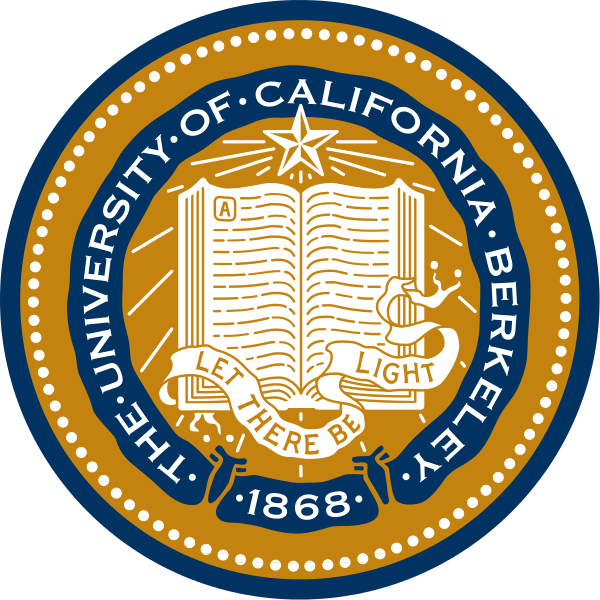 Since the economic downturn hit in 2008, many public colleges have attempted to become destinations for students from all over the country. Institutions like the University of Vermont have long pursued such a strategy, but they have been aided by the fact that there aren't that many Vermonters. In states like California, such moves have been controversial. The University of California agreed to some limits on out-of-staters in a deal with then governor Jerry Brown to get more money.
Since the economic downturn hit in 2008, many public colleges have attempted to become destinations for students from all over the country. Institutions like the University of Vermont have long pursued such a strategy, but they have been aided by the fact that there aren't that many Vermonters. In states like California, such moves have been controversial. The University of California agreed to some limits on out-of-staters in a deal with then governor Jerry Brown to get more money.
This year's survey found that 57 percent of admissions leaders at public colleges say they have been seeking to increase out-of-state enrollment, and 75 percent of them report being successful.
Twenty percent report facing political scrutiny over the practice.
However, more admissions directors than in the past value out-of-state students for their brains (or other attributes), not tuition revenue. Only 41 percent said out-of-state students were essential for tuition revenue, down from 55 percent in 2016.
International Students
 Part of the out-of-state enrollment picture, for public and private colleges, is international students. Fifty-eight percent of admissions directors are concerned about maintaining the same number of international students they have had, up one percentage point from last year.
Part of the out-of-state enrollment picture, for public and private colleges, is international students. Fifty-eight percent of admissions directors are concerned about maintaining the same number of international students they have had, up one percentage point from last year.
The admissions directors don't have much doubt about at least one cause for their problems. Fifty-four percent strongly agree and 19 percent agree that "the policies and rhetoric of the Trump administration have made it more difficult to recruit international students."
In the current environment, a slight majority (51 percent) say that they will increase scholarships to maintain current enrollment levels. That figure is up sharply from previous years.
And 38 percent said that they were "more open to using commission-paid agents in recruiting."
The Image of Higher Education
Most college admissions directors (91 percent) are concerned about the image of higher education, strongly agreeing or agreeing that "higher education needs to do a better job of explaining the value of earning college degrees."
This fear that the public doesn't understand is most evident with regard to liberal arts education.
Only 7 percent of admissions directors believe that parents "of prospective students understand the value of a liberal arts education." Less than 5 percent said that students understand the value of a liberal arts education.
Who to Recruit?
One of areas that provides for an interesting comparison of public and private colleges is the focus of their recruitment. The question was phrased "This year, at my institution, I am likely to increase my recruitment efforts for the following populations of undergraduate applicants."
In many of the answers (full-time students and minority students, for example), the public and private answers are similar. But in many others, it is the publics that are going after older, nontraditional students.
The following table indicates the percentage who answered that they strongly agreed.
| Public | Private | |
| Full-time undergraduates | 60% | 62% |
| Minority students | 52% | 51% |
| Transfer students | 53% | 46% |
| First-generation college students | 51% | 30% |
| Online students | 29% | 29% |
| Out-of-state students | 29% | 36% |
| Veterans/military personnel | 38% | 18% |
| Students older than 24 | 40% | 19% |
| Students recruited with merit scholarships | 19% | 35% |
| International students | 21% | 26% |
| Full-pay students | 25% | 27% |
| Part-time undergraduates | 42% | 11% |
Waiting Lists
Waiting lists have been a growing concern of high school counselors in recent years. They have complained that some colleges place too many students on waiting lists (in some cases more students than are admitted).
The results show that in recent years, only 19 percent of college admissions leaders say they have admitted more than 5 percent of their class from the waiting list. And 18 percent admitted no students from the waiting list.
College admissions directors are more likely to agree (49 percent) than disagree (24 percent) that waiting lists have grown too long.
This may be in part to avoid outright rejections. Twenty-three percent said they used waiting lists in part "to avoid rejecting strong applicants." The figure at private colleges was 27 percent.
Digital Tools in the Admissions Process
When it comes to the digital tools that colleges use to recruit students, the most common answer is that colleges are satisfied -- but not very satisfied.
Eighty-eight percent of colleges use chat bots, social media or other digital communication tools to interact with students. Eight percent said that they were "very satisfied" with the way the college uses these tools to interact with potential applicants. Sixty-one percent said that were satisfied.
Asked if they had a tool to predict the likelihood that a potential applicant would apply, be admitted or enroll, just over half (53 percent) percent said they had such a tool. Asked if they were satisfied with such tools, 15 percent said that they were very satisfied, and 62 percent said that they were satisfied.
The admissions experts also answered questions on their satisfaction with various tools used to recruit students.
| Very Satisfied | Satisfied | Dissatisfied | Very Dissatisfied | |
| Direct communication with applicants | 16% | 63% | 20% | 1% |
| Giving students a clear path to enrollment and graduation | 17% | 50% | 29% | 4% |
| Marketing | 11% | 51% | 27% | 10% |
| Promoting our academic programs | 8% | 53% | 32% | 6% |
Community Colleges
Many community colleges nationally have been struggling with enrollment. This year's survey asked community college admissions leaders what factors were at play. The most popular answer was competition from nonprofit colleges and universities, followed by public discussion that degrees and certificates do not help people get ahead economically and competition from the for-profit sector.
Tuition rates were half the totals of those on top of the list.
| Competition from nonprofit colleges and universities | 88% |
| Public discussions questioning the value of college degrees or certificates | 83% |
| Competition from for-profit colleges | 80% |
| Insufficient marketing | 80% |
| Prospective students go to colleges where they can earn a bachelor's degree | 77% |
| Student fears of borrowing | 67% |
| Reputation for poor degree-completion rates | 58% |
| Lack of desirable programs | 43% |
| Tuition rates | 40% |
For-profit higher education has also been struggling. And 41 percent of the community colleges reported gaining some students who might have gone to a for-profit previously.
And asked if they were concerned about the decreased regulation of for-profit higher education by the Trump administration, 63 percent said they strongly agreed, and 21 percent said they agreed.
